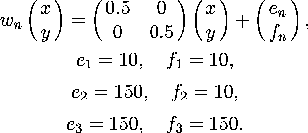Iterated Function Systems
One of the more common, and more general, ways to generate fractals is through
Iterated Function Systems (IFSs). In the following I give an overview of the
theory of IFSs, including definitions, key theorems, and some examples. I leave
out most proofs, and ignore a number of details. For more complete expositions
see one of the references in the Further Reading
section.
Def: A contraction mapping on the
metric space (X,d) is
a mapping f:X->X from the metric space into itself, such that:

for some real constant 0<= c <1, the contractivity factor.
Theorem:(The Contraction Mapping Theorem) Let f:X->X be a contraction
mapping on a metric space (X,d). Then f has exactly one fixed point, a, in X,
and:

Contraction mappings are the elementary building blocks of IFSs, but they
are un-interesting by themselves (as seen by the above theorem).
Def: An (hyperbolic) iterated function system is a metric space
(X,d) together with a finite set of contraction mappings on that space. The
notation for such an iterated function system (IFS) is:

and it has a contractivity factor:

Def: Given a metric space (X,d), we define another metric space
(H(X),h(d)). Where H(X) is the set of all nonempty compact subsets of X, and
h(d) is the Hausdorf distance
between two elements of H(X).
This metric space (H,h) has been called the space on which fractals live. In a
general way a fractal is an element of this space, however, this definition
doesn't account for our intuitive ideas about what a fractal should be (since it
includes lot's of normal geometric objects.)
Theorem: Let {X; wn, n=1,2,...,N} be a hyperbolic iterated function
system on the metric space (X,d) with contractivity factor s. Then the map
W:H(X)->H(X) defined by:

where

is a contraction mapping on (H(X),h(d)) with contractivity factor s. Further,
the unique fixed point, A, of W is given by:

This subspace A is called the attractor of the IFS.
It is the attractors of IFSs, which live in H(X), which are really fractals.
Indeed, almost all of the well known fractals, as well as many less well
known ones, are the attractors of appropriate IFSs. See some
examples generated using Fractalina.
Once an IFS has been defined it is usually necessary to compute the attractor.
When the transformations of the IFS can be represented as a matrix transformation
on a vector plus a translation, there are two fairly simple ways to compute the
attractor: the deterministic algorithm, and the random iteration algorithm.
The deterministic algorithm:
The deterministic algorithm for finding the attractor of an IFS is the
straightfroward application of the map W( ), defined above. That is, an
iteration consists of applying each transformation to the current set, and then
taking the union of the resulting sets. The limit of this process gives you the
attractor of the IFS, as shown above.
Below is an applet that implements the deterministic algorithm for the IFS:

Notice that the initial set can vary widely, but the result converges rapidly to
the attractor of the IFS. (The attractor of this IFS is the well known
Sierpinski triangle.)
To chose the initial set drag in the window, then use the Iterate button to
step through iterations on that set.
The Random Iteration Algorithm
Theorem: Let (X,d) be a metric space, and let {X; wn} be a
hyperbolic IFS. Let wn depend continuously
on a parameter p (p an element of a compact metric space), for each n. Then the
attractor of the IFS, A(p), depends continuously on p.
This theorem provides the mathematical basis for animations of IFSs (in
particular for Franimate!). The effect
implied here has been called "blowing in the wind", because an imaginary
fractal tree can be made to blow in an imaginary mathematical breeze, by
continuously varying a parameter to the IFS of the "tree".
There are many good resources for information on IFSs. Among them are:
Fractals Everywhere, Michael Barnsley, Academic Press Inc., 1988.
 Back
Back









 Back
Back